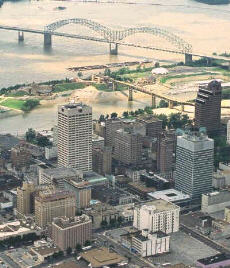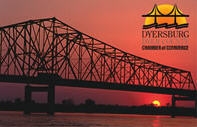Erratic funding slows bridge work
Due largely to rising material costs, retrofitting the Hernando DeSoto Bridge to reduce its earthquake vulnerability is taking twice as long as planned, at least 12 years.
By Tom Charlier / The Commercial Appeal
May 14, 2006
Bill Clinton was in the White House and the NBA Grizzlies still were in Vancouver when work began on a project to make Hernando DeSoto Bridge virtually earthquake-proof.
Now, six years later, state transportation officials say crews probably won't finish reinforcing the 33-year-old structure in Downtown Memphis until George W. Bush's successor is wrapping up his or her first term as president in 2012.
The timetable for the work, originally projected at five to eight years, has been roughly doubled to at least 12 years -- more than twice the amount of time it took to construct the bridge -- because of funding delays, officials say. At the same time, sharp increases in the price of steel and concrete have pushed estimates for the overall cost of the work from $170 million up to around $200 million. That's not far off the inflation-adjusted figure of $260 million it cost to build the bridge.
As a result, by the time it's finished the bridge-retrofit job will be one of longest-running and most expensive projects the Tennessee Department of Transportation has ever handled.
"I don't think there's ever been (a project) like this," said Bob Parrish, assistant to the regional director for TDOT.
Department spokesman Kim Keelor said the expanding timetable and costs prove one main point. "It's easier to build a bridge from scratch than it is to rebuild or retrofit an existing one."
 The project is designed to ensure that the vital span carrying Interstate 40 across the Mississippi River withstands a major earthquake along the New Madrid fault zone. The work includes making footings and foundations bigger and stronger and installing special bearings that allow the bridge to absorb the forces of a quake without collapsing.
The project is designed to ensure that the vital span carrying Interstate 40 across the Mississippi River withstands a major earthquake along the New Madrid fault zone. The work includes making footings and foundations bigger and stronger and installing special bearings that allow the bridge to absorb the forces of a quake without collapsing.
So far, crews have completed retrofitting the portion of the span directly over the Mississippi. They're now working on approaches on the Memphis side and on spans leading to the bridge on the Arkansas side.
Last month, TDOT opened a low bid of $53.5 million on a project entailing the retrofitting of two spans across the bottomland area on the Arkansas side. When that job is done, about three years from now, the overall work will be three-fourths complete, said Fred Stephenson, project engineer for TRC Imbsen, the firm hired by TDOT to design and oversee the job.
The delays reflect the complex nature of the project and the drawn-out process for funding it.
To keep the project on a manageable scale and maximize competitive bidding, planners divided it into 20 segments, some of which have been combined in contracts.
"One thing about this work, it's all in the details," Stephenson said. "The whole system has to work together."
The project gets 80 percent of its funding from the federal government, and Stephenson said officials originally expected allocations to average about $20 million annually.
Instead, they have fluctuated wildly. After initial outlays of about $33 million and $23 million, the project received only $6 million during 2002, Stephenson said. Funding rebounded to $16 million and $23 million the following two years, but in 2005, "we got no money," he said.
A two-year delay before the passage of the federal highway bill last year caused some of the funding glitches.
Although officials don't expect any further cutoff in funds, any reductions could mean an even later completion date. "It could easily go more than 12 years," Stephenson said.
But for all the time, money and complications involved, the project is well worth it, local officials and earthquake researchers say.
The other local highway span crossing the Mississippi, the 57-year-old Memphis & Arkansas Bridge, is much more vulnerable than the Hernando DeSoto span was even before the  retrofitting work, officials say. And the other bridge in Tennessee -- along I-155 west of Dyersburg -- sits almost directly atop one of the New Madrid faults.
retrofitting work, officials say. And the other bridge in Tennessee -- along I-155 west of Dyersburg -- sits almost directly atop one of the New Madrid faults.
"It's really important to have something crossing the river" after a quake, said Paul Bodin, an associate professor at the Center for Earthquake Research and Information at the University of Memphis.
-- Tom Charlier: 529-2572
Read about the BALL BEARINGS the DeSoto Bridge is sitting on.
St. Louis Highway 40 quake protection drags on
By Ken Leiser ST. LOUIS POST-DISPATCH
06/08/2008
ST. LOUIS — When Missouri set out to strengthen the elevated section of Highway 40 downtown against earthquakes, officials said it would take a few years and cost a little more than $11 million.
But more than a decade after work began on the nearly 1.5-mile connector to the Poplar Street Bridge, it remains unfinished. Two short stretches are not done, leaving them unprotected against a major quake.
And the projected cost of the strengthening work has grown tenfold, to $110.4 million.
Memphis DeSoto Bridge Pier Settles a few inches
MEMPHIS, Tenn. — The bridge that carries Interstate 40 across the Mississippi River at Memphis was open after being closed for nearly nine hours Monday Aug 26, 2007 due to structural concerns.
Engineers closed the Hernando DeSoto Bridge Monday morning after rush hour after finding a bridge pier in a construction zone had settled 3 1/2 inches overnight. Tennessee Department of Transportation chief engineer Paul Degges said the closing was a proactive move that allowed inspectors to take a very thorough look at the bridge that links Memphis and West Memphis, Arkansas.
Traffic was diverted for about nine hours onto the (older) I-55 bridge, which runs parallel to I-40.
The settling came during a construction project designed to make the Hernando DeSoto Bridge safer in case of earthquake. The New Madrid Fault Zone extends along the river.
The bridge pier settling likely happened when longer pilings were sunk for the retrofit construction, according to an Arkansas Highway engineer, (?) Nilles.
The six-lane span carries more than 35,000 vehicles a day.
--from Foxnews.com, AP and Memphis Commercial Appeal
Powered by ShowMe-Net